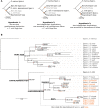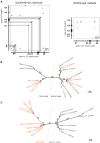Parallel Evolution of Ameloblastic scpp Genes in Bony and Cartilaginous Vertebrates
- PMID: 35535508
- PMCID: PMC9122587
- DOI: 10.1093/molbev/msac099
Parallel Evolution of Ameloblastic scpp Genes in Bony and Cartilaginous Vertebrates
Abstract
In bony vertebrates, skeletal mineralization relies on the secretory calcium-binding phosphoproteins (Scpp) family whose members are acidic extracellular proteins posttranslationally regulated by the Fam20°C kinase. As scpp genes are absent from the elephant shark genome, they are currently thought to be specific to bony fishes (osteichthyans). Here, we report a scpp gene present in elasmobranchs (sharks and rays) that evolved from local tandem duplication of sparc-L 5' exons and show that both genes experienced recent gene conversion in sharks. The elasmobranch scpp is remarkably similar to the osteichthyan scpp members as they share syntenic and gene structure features, code for a conserved signal peptide, tyrosine-rich and aspartate/glutamate-rich regions, and harbor putative Fam20°C phosphorylation sites. In addition, the catshark scpp is coexpressed with sparc-L and fam20°C in tooth and scale ameloblasts, similarly to some osteichthyan scpp genes. Despite these strong similarities, molecular clock and phylogenetic data demonstrate that the elasmobranch scpp gene originated independently from the osteichthyan scpp gene family. Our study reveals convergent events at the sparc-L locus in the two sister clades of jawed vertebrates, leading to parallel diversification of the skeletal biomineralization toolkit. The molecular evolution of sparc-L and its coexpression with fam20°C in catshark ameloblasts provides a unifying genetic basis that suggests that all convergent scpp duplicates inherited similar features from their sparc-L precursor. This conclusion supports a single origin for the hypermineralized outer odontode layer as produced by an ancestral developmental process performed by Sparc-L, implying the homology of the enamel and enameloid tissues in all vertebrates.
Keywords: Scyliorhinus canicula; fam20°C; scpp; sparc-L; ameloblasts; enamel; enameloid; gene conversion; genomic convergence; jawed vertebrate evolution.
© The Author(s) 2022. Published by Oxford University Press on behalf of Society for Molecular Biology and Evolution.
Figures





Similar articles
-
Evolution of dental tissue mineralization: an analysis of the jawed vertebrate SPARC and SPARC-L families.BMC Evol Biol. 2018 Aug 30;18(1):127. doi: 10.1186/s12862-018-1241-y. BMC Evol Biol. 2018. PMID: 30165817 Free PMC article.
-
Evolutionary genetics of vertebrate tissue mineralization: the origin and evolution of the secretory calcium-binding phosphoprotein family.J Exp Zool B Mol Dev Evol. 2006 May 15;306(3):295-316. doi: 10.1002/jez.b.21088. J Exp Zool B Mol Dev Evol. 2006. PMID: 16358265 Review.
-
The SCPP gene repertoire in bony vertebrates and graded differences in mineralized tissues.Dev Genes Evol. 2009 Mar;219(3):147-57. doi: 10.1007/s00427-009-0276-x. Epub 2009 Mar 3. Dev Genes Evol. 2009. PMID: 19255778 Free PMC article.
-
Divergent Expression of SPARC, SPARC-L, and SCPP Genes During Jawed Vertebrate Cartilage Mineralization.Front Genet. 2021 Nov 25;12:788346. doi: 10.3389/fgene.2021.788346. eCollection 2021. Front Genet. 2021. PMID: 34899866 Free PMC article.
-
SCPP gene evolution and the dental mineralization continuum.J Dent Res. 2008 Jun;87(6):520-31. doi: 10.1177/154405910808700608. J Dent Res. 2008. PMID: 18502959 Review.
Cited by
-
The vertebrate small leucine-rich proteoglycans: amplification of a clustered gene family and evolution of their transcriptional profile in jawed vertebrates.G3 (Bethesda). 2025 Mar 18;15(3):jkaf003. doi: 10.1093/g3journal/jkaf003. G3 (Bethesda). 2025. PMID: 39774651 Free PMC article.
-
Dental structure and tooth attachment modes in the common fangtooth Anoplogaster cornuta (Valenciennes, 1833) (Actinopterygii; Trachichthyiformes; Anoplogastridae).PLoS One. 2022 Aug 12;17(8):e0272860. doi: 10.1371/journal.pone.0272860. eCollection 2022. PLoS One. 2022. PMID: 35960777 Free PMC article.
-
Emergence of saliva protein genes in the secretory calcium-binding phosphoprotein (SCPP) locus and accelerated evolution in primates.bioRxiv [Preprint]. 2024 Feb 15:2024.02.14.580359. doi: 10.1101/2024.02.14.580359. bioRxiv. 2024. PMID: 38405690 Free PMC article. Preprint.
-
Paleo-evo-devo implications of a revised conceptualization of enameloids and enamels.Biol Rev Camb Philos Soc. 2025 Jun;100(3):1047-1066. doi: 10.1111/brv.13173. Epub 2024 Dec 18. Biol Rev Camb Philos Soc. 2025. PMID: 39692055 Free PMC article. Review.
-
Ganoin and acrodin formation on scales and teeth in spotted gar: A vital role of enamelin in the unique process of enamel mineralization.J Exp Zool B Mol Dev Evol. 2023 Nov;340(7):455-468. doi: 10.1002/jez.b.23183. Epub 2022 Dec 4. J Exp Zool B Mol Dev Evol. 2023. PMID: 36464775 Free PMC article.
References
-
- Berio F, Broyon M, Enault S NP, Lopez-Romero FA, Debiais-Thibaud M. 2021. Diversity and evolution of mineralized skeletal tissues in chondrichthyans. Front Ecol Evol. 9:1–19.
Publication types
MeSH terms
Substances
LinkOut - more resources
Full Text Sources
Research Materials
Miscellaneous

